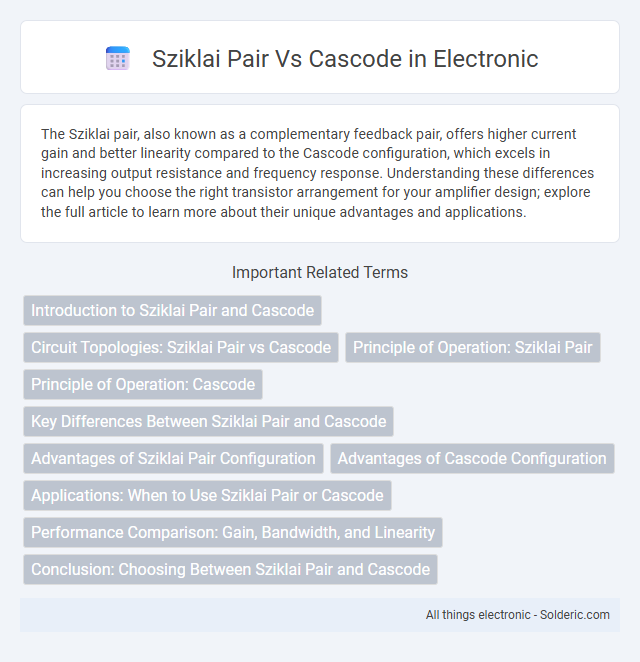The Sziklai pair, also known as a complementary feedback pair, offers higher current gain and better linearity compared to the Cascode configuration, which excels in increasing output resistance and frequency response. Understanding these differences can help you choose the right transistor arrangement for your amplifier design; explore the full article to learn more about their unique advantages and applications.
Comparison Table
| Feature | Sziklai Pair | Cascode |
|---|---|---|
| Configuration | Two transistors, complementary types, arranged to mimic a Darlington pair | Two transistors stacked, same type, for improved high-frequency performance |
| Gain | High current gain, similar to Darlington | Moderate gain, mainly used for bandwidth improvement |
| Input Voltage Drop | Lower than Darlington (~0.6V) | Standard transistor voltage drop (~0.7V) |
| Frequency Response | Limited by transistor bandwidth | Improved high-frequency response, reduced Miller effect |
| Applications | Audio amplifiers, switching with lower voltage drop | High-frequency amplifiers, RF circuits, low-noise stages |
| Input Impedance | High input impedance | Moderate input impedance |
| Complexity | Simple two-transistor design | Simple two-transistor stacked design |
Introduction to Sziklai Pair and Cascode
The Sziklai pair, also known as the complementary feedback pair, consists of two transistors configured to provide high current gain similar to a Darlington pair but with improved frequency response and lower saturation voltage. The cascode configuration uses a common-emitter transistor stage followed by a common-base stage, offering high gain, increased bandwidth, and reduced Miller effect, making it ideal for high-frequency applications. Both configurations optimize transistor performance, with the Sziklai pair focusing on efficiency and the cascode prioritizing speed and stability.
Circuit Topologies: Sziklai Pair vs Cascode
The Sziklai pair, also known as the complementary feedback pair, combines an NPN and PNP transistor to achieve high current gain with fewer distortions, making it ideal for output stages in audio amplifiers. In contrast, the cascode topology stacks two transistors--one common-emitter followed by a common-base configuration--to improve gain-bandwidth product and reduce input-output capacitance, benefiting high-frequency applications. Understanding these distinct circuit topologies helps you select the appropriate design for your amplifier or RF circuits, balancing gain, frequency response, and distortion requirements.
Principle of Operation: Sziklai Pair
The Sziklai pair, also known as the complementary feedback pair, operates by combining an NPN and a PNP transistor to achieve high current gain with a single-ended input. It functions by using the input transistor to drive the second transistor's base, enabling a low input saturation voltage and improved linearity compared to a single transistor stage. This configuration offers enhanced voltage gain and fast switching, making it efficient for amplifier and switching applications.
Principle of Operation: Cascode
The Cascode amplifier configuration uses a common-emitter stage followed by a common-base stage, effectively reducing the Miller effect and increasing bandwidth. It operates by isolating the input from the output voltage variations, thus enhancing high-frequency performance and gain stability. This principle of operation makes Cascode devices particularly advantageous in RF and high-speed analog circuits compared to the Sziklai pair.
Key Differences Between Sziklai Pair and Cascode
The Sziklai pair combines a PNP and NPN transistor to achieve high current gain with a single input transistor, offering improved linearity and lower distortion compared to basic transistor configurations. The Cascode configuration stacks two transistors to increase gain and bandwidth while minimizing Miller effect, enhancing high-frequency performance and stability. Your choice depends on whether you need higher linearity and gain for audio applications (Sziklai) or improved frequency response and noise reduction in RF and amplifier circuits (Cascode).
Advantages of Sziklai Pair Configuration
The Sziklai pair configuration offers improved gain bandwidth and better input-output isolation compared to the Cascode arrangement, making it suitable for high-frequency amplifier applications. It provides a higher input impedance and lower output impedance, enhancing overall signal linearity and reducing distortion. This configuration also simplifies biasing and enables easier thermal stability control in bipolar transistor circuits.
Advantages of Cascode Configuration
The cascode configuration offers high gain and increased bandwidth due to its reduced Miller effect and improved frequency response, making it ideal for high-frequency applications. It provides better input-output isolation, enhancing stability and minimizing distortion in amplifier circuits. Compared to the Sziklai pair, the cascode's low input capacitance and high output impedance contribute to superior performance in radio frequency and analog signal processing.
Applications: When to Use Sziklai Pair or Cascode
Sziklai pairs excel in audio amplification and low-voltage applications due to their high gain and improved linearity, making them ideal for your headphone amplifiers and preamplifier stages. Cascode configurations are preferred in high-frequency circuits and RF amplifiers because they offer superior bandwidth and reduced Miller capacitance, enhancing signal integrity at gigahertz ranges. Choosing between them depends on your need for gain versus frequency response, where Sziklai pairs prioritize voltage amplification, and cascodes optimize speed and stability.
Performance Comparison: Gain, Bandwidth, and Linearity
Sziklai pair offers higher current gain and better linearity compared to the cascode configuration, making it suitable for audio amplification where distortion must be minimized. Cascode circuits excel in bandwidth performance due to reduced Miller capacitance, providing superior high-frequency response and stability in RF applications. Your choice depends on prioritizing gain and linearity with the Sziklai pair or bandwidth and frequency handling with the cascode design.
Conclusion: Choosing Between Sziklai Pair and Cascode
The choice between a Sziklai pair and a cascode configuration depends on your specific circuit requirements such as gain, bandwidth, and complexity. Sziklai pairs offer higher current gain with fewer distortions, making them suitable for low-frequency and low-power applications. Cascode stages provide better high-frequency performance and improved output impedance, ideal for RF and high-speed analog circuits.
Sziklai pair vs Cascode Infographic

 solderic.com
solderic.com